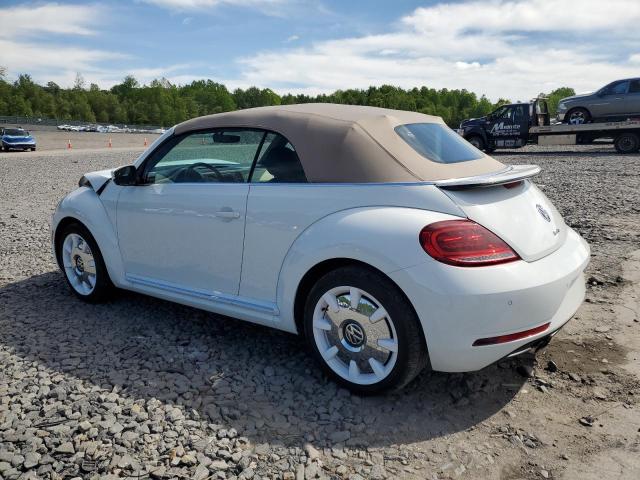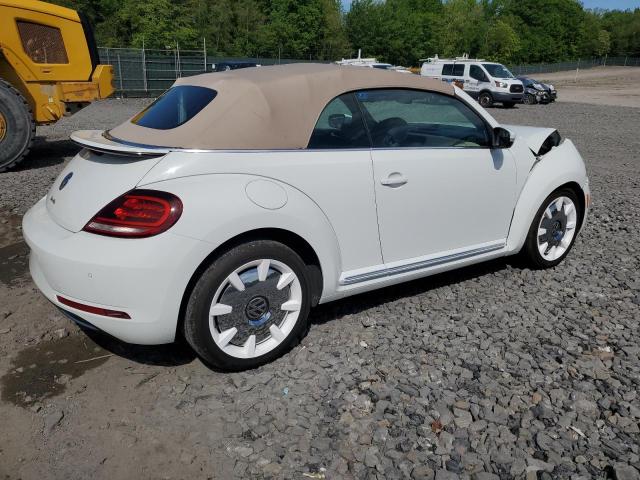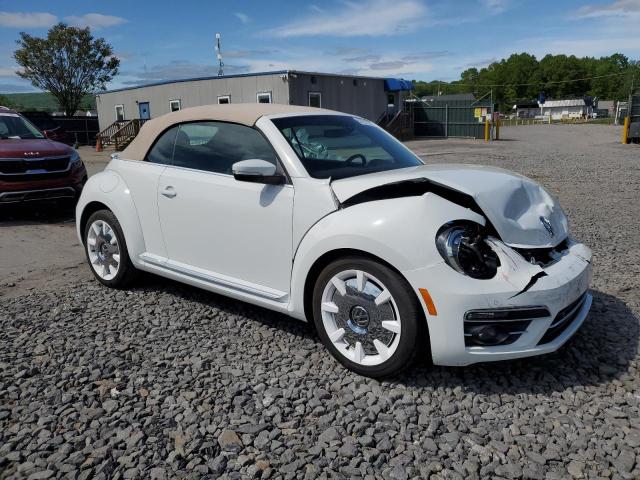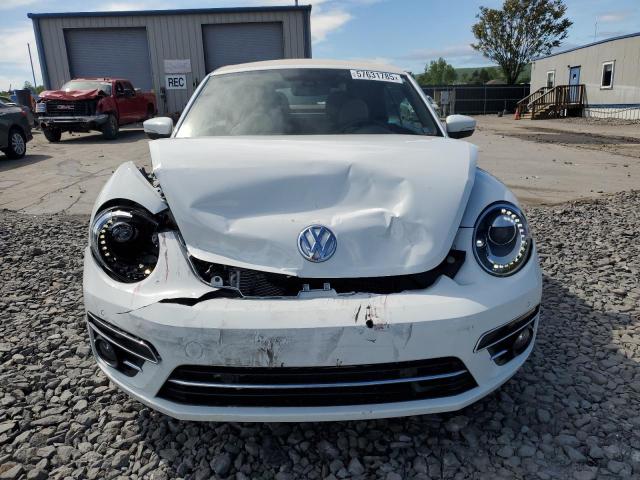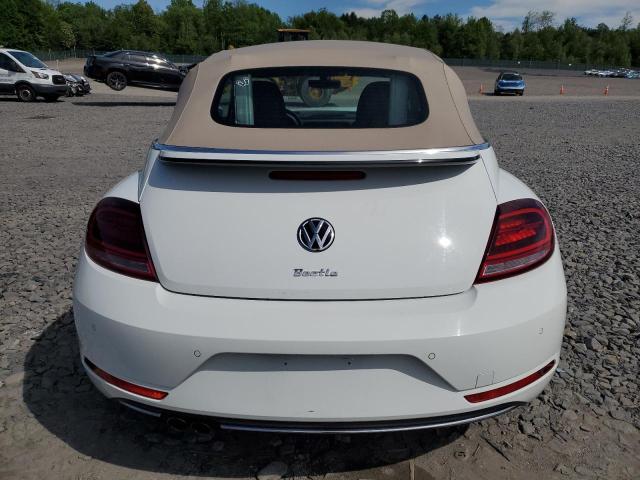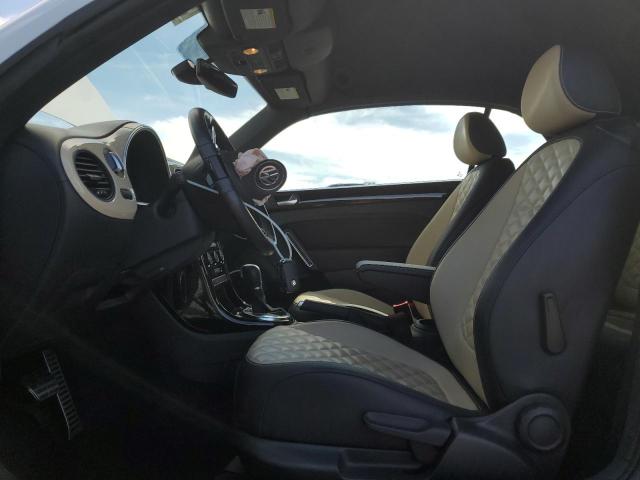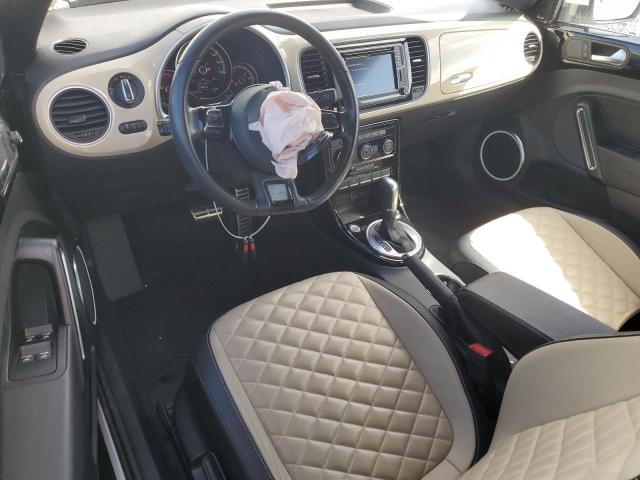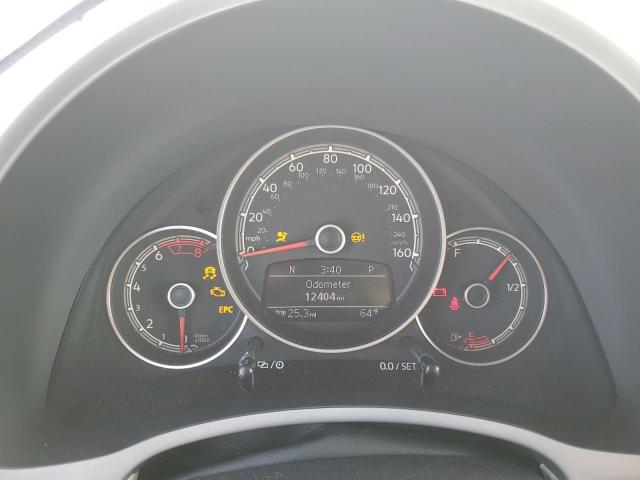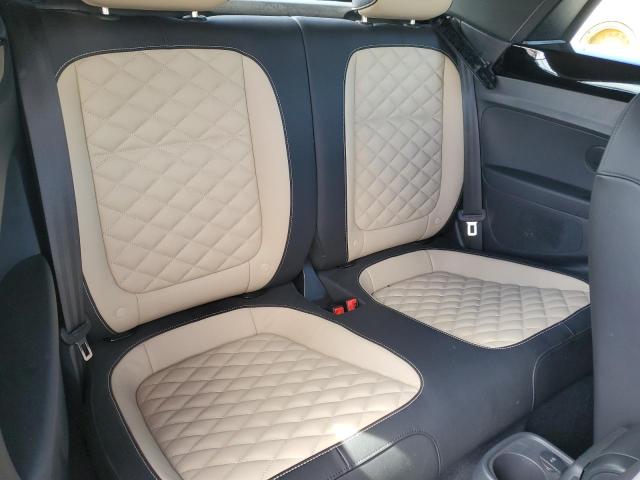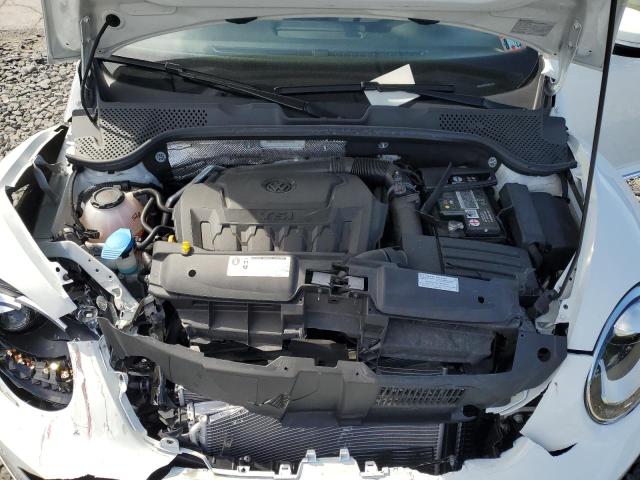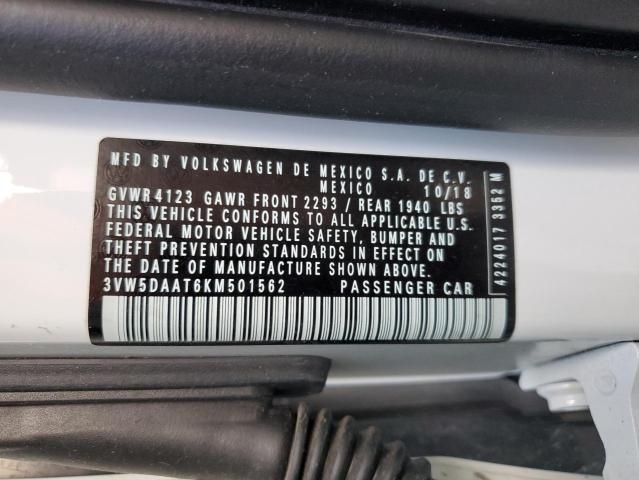2019 VOLKSWAGEN BEETLE | 3VW5DAAT6KM501562
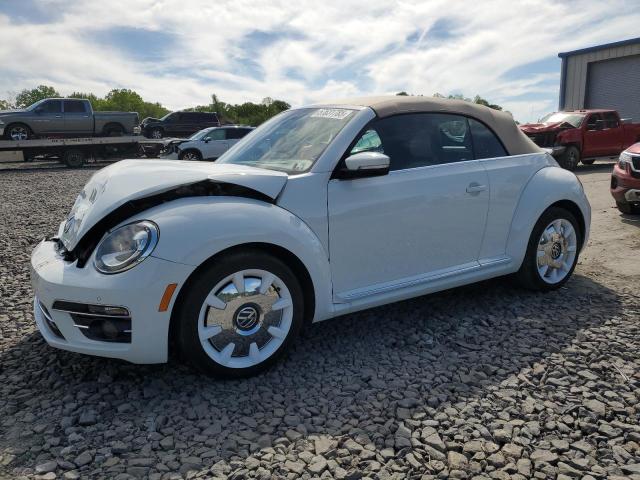 ❯
❯
Specifications
4
~$30,000
Engine: 2.0L turbocharged inline-4
Torque: 280 Nm
0–100 km/h: ~6.6 s
In its final generation, the Beetle embraced a more athletic stance and drive experience—especially in its 2.0 TSI configuration. With 210 hp and a responsive 6-speed DSG transmission, it could reach 100 km/h in just over 6 seconds, a significant upgrade over earlier versions. The engine’s wide torque band gave it strong mid-range acceleration, making it feel punchy in urban sprints and light highway overtakes.
Underneath, the Beetle shared its platform with the Golf and Jetta, offering a refined suspension setup with a more planted feel than its cutesy predecessor. While the steering remained light and comfort-oriented, the ride was well controlled and surprisingly composed in tight corners. Special trims like the R-Line added larger wheels, stiffer dampers, and sportier steering feedback, improving its agility without compromising its daily drivability.
While never intended as a hot hatch, the 2012–2019 Beetle carved a niche as a style-focused compact with respectable performance. It stood apart from similarly sized rivals by blending retro aesthetics with modern turbocharged dynamics. Buyers who wanted personality and punch without sacrificing comfort found in the Beetle an unorthodox but engaging choice—especially in Turbo or R-Line trims.
Body Styles
The Beetle was available as a 3-door hatchback coupe or a 2-door convertible, both with seating for four. Compared to the previous “New Beetle” (1998–2010), this generation featured a longer, wider, and lower body, giving it a more muscular and less bulbous appearance. The sloping roofline, sculpted fenders, and wide stance helped it shed its “cute car” image for something sportier and more grounded. The convertible model retained the same proportions with a high-quality soft-top that folded in under 10 seconds, preserving trunk access and rear visibility. Both variants shared identical dimensions and underpinnings, with design cues like the integrated rear spoiler, low hood, and rounded headlights preserving the model’s unmistakable silhouette.
Model Name Meaning (Manufacturer)
The name “Beetle” (in German: Käfer) was never a codename—it was the people’s name for the car from the beginning. While the original model was officially the Volkswagen Type 1, its bug-like shape and small stature led to the affectionate nickname that stuck. Volkswagen later embraced it as the formal name, preserving decades of heritage and global recognition. In this generation, the name symbolized a retro-futuristic revival of the brand’s most iconic shape.
Model Name Meaning (Languages)
“Beetle” is the English word for a type of insect with a rounded body and hard shell—apt for describing the car’s domed, compact silhouette. Its linguistic familiarity and quirky connotation make it instantly memorable across global markets. In many languages, translations of “Beetle” or “Käfer” evoke similar visual or emotional associations, reinforcing the brand’s universally recognized charm and nostalgic appeal.
Body & Interior Colors and Rims
Volkswagen offered a broad palette of body colors for the Beetle, from classic tones like Pure White and Tornado Red to vibrant shades such as Habanero Orange, Denim Blue, and Sandstorm Yellow. Limited editions like the Dune and Final Edition introduced exclusive metallics like Safari Uni and Stonewashed Blue. Many colors could be paired with contrasting black roofs or mirror caps, and select trims included retro-style side graphics, body-colored spoilers, or chrome-accented bumpers. Convertible models often matched the soft-top to the paint for a cleaner silhouette, or contrasted it for a sportier look.
Inside, the Beetle featured an expressive cabin with body-colored dash inserts, circular air vents, and retro-font gauges. Trim options included Titan Black, Beige, or unique two-tone combinations like Brown-Cornsilk, with upholstery in cloth, V-Tex leatherette, or genuine leather on upper trims. Contrasting stitching, ambient lighting, and optional dash-mounted gloveboxes evoked the original Beetle’s simplicity, while modern infotainment with touchscreen displays and Fender premium audio elevated the experience.
Wheel choices ranged from 16-inch steel rims with retro hubcaps to 18- and 19-inch aluminum alloys in machined or gloss black finishes. Designs like the “Heritage Wheel” or five-spoke “Twister” and “Tornado” patterns reinforced the car’s nostalgic yet playful character. Many editions had unique wheel badges, colored trim rings, or exclusive spoke finishes depending on trim level or market.
Top Expensive Options
- Fender Premium Audio System with Subwoofer: $595
- Bi-Xenon Headlights with LED Daytime Lights: $995
- Panoramic Tilting Sunroof: $1,000
- Leather Sport Seats with Heating: $1,500
- Volkswagen Car-Net Navigation with 6.3" Touchscreen: $895
- 19” Tornado Machined Alloy Wheels: $995
- R-Line Exterior Sport Styling Package: $1,095
- Keyless Access with Push-Button Start: $475
- Rearview Camera with Park Distance Control: $495
- Convertible Power Top with Heated Glass Window: $1,800
vs Competitors
The Beetle was positioned uniquely in the compact car segment, offering style and nostalgia where others offered neutrality. Compared to the Mini Cooper, it offered more interior space and a smoother ride but lacked the Mini’s razor-sharp handling. Against the Fiat 500, the Beetle felt more mature and refined, with better highway composure and a more powerful top engine. When compared with mainstream hatchbacks like the Ford Focus or Honda Civic, it couldn’t match practicality or rear-seat usability but stood apart in design and personality. The convertible variant competed favorably with soft-top alternatives like the Mini Convertible or Fiat 500C, offering better structural integrity and a more cohesive driving experience.
Fun Fact
Volkswagen produced a special "Beetle Final Edition" in 2019 to commemorate the end of the Beetle’s long production legacy. Offered in exclusive colors like Safari Uni and Stonewashed Blue, it included vintage-inspired design cues like heritage wheels and dash plaques. The very last unit—a Denim Blue coupe—rolled off the Puebla, Mexico production line on July 10, 2019, marking the official end of one of the most iconic and longest-running automotive nameplates in history.
Lot Details
-
Sale Date11/Jun/2025
-
Lot Number57631785
-
Location
-
Odometer0 miles (0 km)
-
Primary Damage:FRONT END
-
Secondary DamageSIDE
-
Fuel
-
Engine Type2.0L 4
-
Transmission
-
Drive Type
-
Color
Final Bid Volkswagen Beetle (2019)
$11,100
$11,100
$11,100
Specifications
4
~$30,000
Torque:
0–100 km/h:
In its final generation, the Beetle embraced a more athletic stance and drive experience—especially in its 2.0 TSI configuration. With 210 hp and a responsive 6-speed DSG transmission, it could reach 100 km/h in just over 6 seconds, a significant upgrade over earlier versions. The engine’s wide torque band gave it strong mid-range acceleration, making it feel punchy in urban sprints and light highway overtakes.
Underneath, the Beetle shared its platform with the Golf and Jetta, offering a refined suspension setup with a more planted feel than its cutesy predecessor. While the steering remained light and comfort-oriented, the ride was well controlled and surprisingly composed in tight corners. Special trims like the R-Line added larger wheels, stiffer dampers, and sportier steering feedback, improving its agility without compromising its daily drivability.
While never intended as a hot hatch, the 2012–2019 Beetle carved a niche as a style-focused compact with respectable performance. It stood apart from similarly sized rivals by blending retro aesthetics with modern turbocharged dynamics. Buyers who wanted personality and punch without sacrificing comfort found in the Beetle an unorthodox but engaging choice—especially in Turbo or R-Line trims.
Body Styles
The Beetle was available as a 3-door hatchback coupe or a 2-door convertible, both with seating for four. Compared to the previous “New Beetle” (1998–2010), this generation featured a longer, wider, and lower body, giving it a more muscular and less bulbous appearance. The sloping roofline, sculpted fenders, and wide stance helped it shed its “cute car” image for something sportier and more grounded. The convertible model retained the same proportions with a high-quality soft-top that folded in under 10 seconds, preserving trunk access and rear visibility. Both variants shared identical dimensions and underpinnings, with design cues like the integrated rear spoiler, low hood, and rounded headlights preserving the model’s unmistakable silhouette.
Model Name Meaning (Manufacturer)
The name “Beetle” (in German: Käfer) was never a codename—it was the people’s name for the car from the beginning. While the original model was officially the Volkswagen Type 1, its bug-like shape and small stature led to the affectionate nickname that stuck. Volkswagen later embraced it as the formal name, preserving decades of heritage and global recognition. In this generation, the name symbolized a retro-futuristic revival of the brand’s most iconic shape.
Model Name Meaning (Languages)
“Beetle” is the English word for a type of insect with a rounded body and hard shell—apt for describing the car’s domed, compact silhouette. Its linguistic familiarity and quirky connotation make it instantly memorable across global markets. In many languages, translations of “Beetle” or “Käfer” evoke similar visual or emotional associations, reinforcing the brand’s universally recognized charm and nostalgic appeal.
Body & Interior Colors and Rims
Volkswagen offered a broad palette of body colors for the Beetle, from classic tones like Pure White and Tornado Red to vibrant shades such as Habanero Orange, Denim Blue, and Sandstorm Yellow. Limited editions like the Dune and Final Edition introduced exclusive metallics like Safari Uni and Stonewashed Blue. Many colors could be paired with contrasting black roofs or mirror caps, and select trims included retro-style side graphics, body-colored spoilers, or chrome-accented bumpers. Convertible models often matched the soft-top to the paint for a cleaner silhouette, or contrasted it for a sportier look.
Inside, the Beetle featured an expressive cabin with body-colored dash inserts, circular air vents, and retro-font gauges. Trim options included Titan Black, Beige, or unique two-tone combinations like Brown-Cornsilk, with upholstery in cloth, V-Tex leatherette, or genuine leather on upper trims. Contrasting stitching, ambient lighting, and optional dash-mounted gloveboxes evoked the original Beetle’s simplicity, while modern infotainment with touchscreen displays and Fender premium audio elevated the experience.
Wheel choices ranged from 16-inch steel rims with retro hubcaps to 18- and 19-inch aluminum alloys in machined or gloss black finishes. Designs like the “Heritage Wheel” or five-spoke “Twister” and “Tornado” patterns reinforced the car’s nostalgic yet playful character. Many editions had unique wheel badges, colored trim rings, or exclusive spoke finishes depending on trim level or market.
Top Expensive Options
- Fender Premium Audio System with Subwoofer: $595
- Bi-Xenon Headlights with LED Daytime Lights: $995
- Panoramic Tilting Sunroof: $1,000
- Leather Sport Seats with Heating: $1,500
- Volkswagen Car-Net Navigation with 6.3" Touchscreen: $895
- 19” Tornado Machined Alloy Wheels: $995
- R-Line Exterior Sport Styling Package: $1,095
- Keyless Access with Push-Button Start: $475
- Rearview Camera with Park Distance Control: $495
- Convertible Power Top with Heated Glass Window: $1,800
vs Competitors
The Beetle was positioned uniquely in the compact car segment, offering style and nostalgia where others offered neutrality. Compared to the Mini Cooper, it offered more interior space and a smoother ride but lacked the Mini’s razor-sharp handling. Against the Fiat 500, the Beetle felt more mature and refined, with better highway composure and a more powerful top engine. When compared with mainstream hatchbacks like the Ford Focus or Honda Civic, it couldn’t match practicality or rear-seat usability but stood apart in design and personality. The convertible variant competed favorably with soft-top alternatives like the Mini Convertible or Fiat 500C, offering better structural integrity and a more cohesive driving experience.
Fun Fact
Volkswagen produced a special "Beetle Final Edition" in 2019 to commemorate the end of the Beetle’s long production legacy. Offered in exclusive colors like Safari Uni and Stonewashed Blue, it included vintage-inspired design cues like heritage wheels and dash plaques. The very last unit—a Denim Blue coupe—rolled off the Puebla, Mexico production line on July 10, 2019, marking the official end of one of the most iconic and longest-running automotive nameplates in history.

